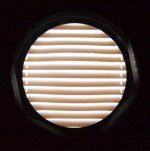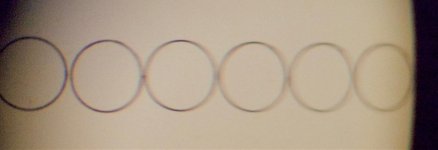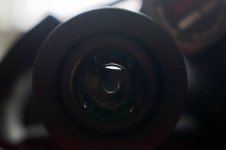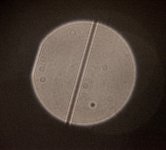henry link
Well-known member
I borrowed a friend’s newly purchased Kowa BD II 10x42 XD and ran some of my usual tests. Here are the results.
FOV, AFOV
For comparison I used a Nikon 10x35 EII with a FOV I’ve measured to be 7º at infinity focus. The FOV of the Kowa 10x42 was very slightly smaller, perhaps around 6.95º, a little more than 0.2º below Kowa’s spec of 7.2º.
The AFOV measured only 64º. That was considerably smaller than Kowa’s spec of 72º. I expected it to be off since Kowa’s spec used the simple formula of multiplying the magnification by the real field which always exaggerates the true AFOV. In this case the real field spec was also exaggerated causing the calculation to be even more off. There was one other contributing factor to the low AFOV, a particular distortion profile which causes the true AFOV to be smaller than expected (see the next section).
DISTORTION
The two photos below on the left illustrate distortion in different ways. The far left photo was made be placing the eyepiece of the binocular about 2 feet from a set of mini blinds and aiming the camera through the objective lens. The straight blinds appear wavy because of a compound distortion sometimes referred to as “mustache” distortion because it causes straight lines to curve into handle bar shapes in the outer part of the field .
Because the photo was made through the objective end it shows the distortion reversed from the way it appears when viewed through the eyepiece. In the photo barrel distortion appears in the center half of the field reversing to pincushion distortion at the field edge. In normal viewing the pincushion is in the center and the barrel is at the edge. Some expensive binoculars use this same distortion profile, like the Swarovski SV and the Zeiss SF. The Kowa profile looks quite similar to the Zeiss SF.
.
The second photo demonstrates how this compound form of rectilinear distortion gives rise to a panning disturbance called the “Globe Effect” or ‘Rolling Ball” The row of six circles was photographed through the Kowa with the field edge on the right. The circles extend from the field edge to about half way to the field center on the left. Notice that there is a gradual horizontal compression of the circular shape from left to right until the last circles near the field edge seem to be foreshortened as if they are moving around the edge of a rotating globe or ball. Another result of this distortion is a smaller than expected AFOV as objects near the edge are crammed into a compressed space.
A few other things are also visible in that photo. Notice that some of the circles are better focused at the 12:00 and 6:00 positions than at 9:00 and 3:00 indicating astigmatism. While this target doesn’t show lateral chromatic aberration very well, it is visible in the form of blue and orange fringes. The last circle on the right has less astigmatism and lateral color because it’s vignetted by somewhat undersized prisms which cause the soft shadow extending into the field from the field stop.
CHROMATIC ABERRATIONS
Longitudinal CA is a non issue, but there is considerable lateral CA, even quite close to the field center. Lateral CA seems to be one of the aberrations for which it’s most difficult for different observers to reach consensus. Even poor performing binoculars won’t show it very vividly under most lighting conditions and it can be artificially induced in good performers through incorrect pupil positioning. I’ve long used a high contrast black and white target designed to induce some amount of lateral color in every binocular. Only by using that target in consistent repeatable conditions and having reference standard binoculars for comparison can I sort out the wheat from the chaff. For this test I used a Nikon 10x35 EII as a reference. The Kowa showed much more lateral color than the Nikon on my target particularly in the most important area near the field center. It’s not possible to say whether the lateral color is generated by the eyepiece or objective group or both, but I’m beginning to suspect that the recent crop of short, light binoculars is pushing past the limits of how low focal ratios can go without performance compromises in this area, even with ED glass.
GLARE
The photo of the binocular interior below shows the causes of the Kowa’s less than perfect glare resistance. The light source is an overcast sky with the binocular pointing unto a dark area in front of it to simulate a field condition that often causes veiling glare; a dark landscape under a brighter, but not necessarily very bright sky. The bright reflections at the bottom edge of the dark exit pupil come from both the objective lens retaining ring and the edges of slightly undersized prisms. When I look through the binocular I see a FOV that's dark toward the top, but flooded with a bright gray haze of veiling glare across the bottom half. That’s the bright reflection at the exit pupil bottom edge as seen far out of focus by the eye.
This isn’t the worst I’ve seen. Even some respected favorites like the Swarovski 8x30 Habicht and 8x32SV are worse, but all these small exit pupil binoculars with reflections near the exit pupil have one thing in common: they tend to show their veiling glare to the eye more readily than larger exit pupil binoculars simply because the exit pupil edge is more likely to enter the eye’s pupil under the lighting conditions that produce the glare.
RESOLUTION
I used a USAF 1951 glass slide target at 10 m with the magnification boosted to 80x. I only measured the full aperture resolution.
The left side was 5.6’ (235/D), the right side 6.5” (270/D). These numbers are bad and worse. For comparison I measured one side of the 10x35 EII at 4.00” (140/D)
STAR-TEST
As expected, a very poor star test brought some explanation for the poor resolution. So much was wrong that the star-test was not very easy to read, but I could see poor correction of spherical aberration, coma from misaligned optics, astigmatism and very defective roof prisms with exactly the same appearance in both sides and which seemed to be aligned with the astigmatism.
The roof prisms really require their own analysis. I’ve never seen anything close in another binocular. The roof edge appears to be so blunt that it is clearly visible as a dark line in the photo below of an extremely defocused star point. Besides completely screwing the star test even if nothing else were wrong this roof edge shows up as fairly extreme spikes perpendicular to the line of the roof edge radiating from any small bright light source in a dark field like a street light. I noticed that Allbinos mentioned the spikes in their overview. In the photo you can also see the edge of an undersized prism cutting into the exit pupil on the left side.
I would be interested to know if others see this same thing in their Kowa’s. To see and photograph the defocused artificial star I focused the binocular at infinity and examined the artificial star at about 3 meters distance.
CONCLUSIONS
This is a binocular I don’t plan to take a second look at, but I couldn’t help but notice that even with all it’s shortcomings I don’t think it’s likely to look obviously bad to a casual hand holding observer. That’s a testimony to just how much can be gotten away with in the world of binocular optics. The image through a low power, hand held instrument can look relatively OK, even when its optics are objectively pretty awful. I could largely dispel that illusion by mounting the Kowa on a tripod next to a Nikon 10x35 EII and focusing on a resolution chart at 30 meters. Then there was quite an obvious difference between the sharp line pairs viewed through Nikon (not itself the sharpest binocular in the world) compared to visibly softer ones viewed through the Kowa. I suspect the flaws of the 10x42 are in the other models as well, possibly even more visible in the 10x32, but probably less visible the 8x42 and especially the 6.5x32 where the flaws will be more forgiven by lower magnification and in daylight benefit from the lower aberrations that result from larger exit pupils.
Henry Link
FOV, AFOV
For comparison I used a Nikon 10x35 EII with a FOV I’ve measured to be 7º at infinity focus. The FOV of the Kowa 10x42 was very slightly smaller, perhaps around 6.95º, a little more than 0.2º below Kowa’s spec of 7.2º.
The AFOV measured only 64º. That was considerably smaller than Kowa’s spec of 72º. I expected it to be off since Kowa’s spec used the simple formula of multiplying the magnification by the real field which always exaggerates the true AFOV. In this case the real field spec was also exaggerated causing the calculation to be even more off. There was one other contributing factor to the low AFOV, a particular distortion profile which causes the true AFOV to be smaller than expected (see the next section).
DISTORTION
The two photos below on the left illustrate distortion in different ways. The far left photo was made be placing the eyepiece of the binocular about 2 feet from a set of mini blinds and aiming the camera through the objective lens. The straight blinds appear wavy because of a compound distortion sometimes referred to as “mustache” distortion because it causes straight lines to curve into handle bar shapes in the outer part of the field .
Because the photo was made through the objective end it shows the distortion reversed from the way it appears when viewed through the eyepiece. In the photo barrel distortion appears in the center half of the field reversing to pincushion distortion at the field edge. In normal viewing the pincushion is in the center and the barrel is at the edge. Some expensive binoculars use this same distortion profile, like the Swarovski SV and the Zeiss SF. The Kowa profile looks quite similar to the Zeiss SF.
.
The second photo demonstrates how this compound form of rectilinear distortion gives rise to a panning disturbance called the “Globe Effect” or ‘Rolling Ball” The row of six circles was photographed through the Kowa with the field edge on the right. The circles extend from the field edge to about half way to the field center on the left. Notice that there is a gradual horizontal compression of the circular shape from left to right until the last circles near the field edge seem to be foreshortened as if they are moving around the edge of a rotating globe or ball. Another result of this distortion is a smaller than expected AFOV as objects near the edge are crammed into a compressed space.
A few other things are also visible in that photo. Notice that some of the circles are better focused at the 12:00 and 6:00 positions than at 9:00 and 3:00 indicating astigmatism. While this target doesn’t show lateral chromatic aberration very well, it is visible in the form of blue and orange fringes. The last circle on the right has less astigmatism and lateral color because it’s vignetted by somewhat undersized prisms which cause the soft shadow extending into the field from the field stop.
CHROMATIC ABERRATIONS
Longitudinal CA is a non issue, but there is considerable lateral CA, even quite close to the field center. Lateral CA seems to be one of the aberrations for which it’s most difficult for different observers to reach consensus. Even poor performing binoculars won’t show it very vividly under most lighting conditions and it can be artificially induced in good performers through incorrect pupil positioning. I’ve long used a high contrast black and white target designed to induce some amount of lateral color in every binocular. Only by using that target in consistent repeatable conditions and having reference standard binoculars for comparison can I sort out the wheat from the chaff. For this test I used a Nikon 10x35 EII as a reference. The Kowa showed much more lateral color than the Nikon on my target particularly in the most important area near the field center. It’s not possible to say whether the lateral color is generated by the eyepiece or objective group or both, but I’m beginning to suspect that the recent crop of short, light binoculars is pushing past the limits of how low focal ratios can go without performance compromises in this area, even with ED glass.
GLARE
The photo of the binocular interior below shows the causes of the Kowa’s less than perfect glare resistance. The light source is an overcast sky with the binocular pointing unto a dark area in front of it to simulate a field condition that often causes veiling glare; a dark landscape under a brighter, but not necessarily very bright sky. The bright reflections at the bottom edge of the dark exit pupil come from both the objective lens retaining ring and the edges of slightly undersized prisms. When I look through the binocular I see a FOV that's dark toward the top, but flooded with a bright gray haze of veiling glare across the bottom half. That’s the bright reflection at the exit pupil bottom edge as seen far out of focus by the eye.
This isn’t the worst I’ve seen. Even some respected favorites like the Swarovski 8x30 Habicht and 8x32SV are worse, but all these small exit pupil binoculars with reflections near the exit pupil have one thing in common: they tend to show their veiling glare to the eye more readily than larger exit pupil binoculars simply because the exit pupil edge is more likely to enter the eye’s pupil under the lighting conditions that produce the glare.
RESOLUTION
I used a USAF 1951 glass slide target at 10 m with the magnification boosted to 80x. I only measured the full aperture resolution.
The left side was 5.6’ (235/D), the right side 6.5” (270/D). These numbers are bad and worse. For comparison I measured one side of the 10x35 EII at 4.00” (140/D)
STAR-TEST
As expected, a very poor star test brought some explanation for the poor resolution. So much was wrong that the star-test was not very easy to read, but I could see poor correction of spherical aberration, coma from misaligned optics, astigmatism and very defective roof prisms with exactly the same appearance in both sides and which seemed to be aligned with the astigmatism.
The roof prisms really require their own analysis. I’ve never seen anything close in another binocular. The roof edge appears to be so blunt that it is clearly visible as a dark line in the photo below of an extremely defocused star point. Besides completely screwing the star test even if nothing else were wrong this roof edge shows up as fairly extreme spikes perpendicular to the line of the roof edge radiating from any small bright light source in a dark field like a street light. I noticed that Allbinos mentioned the spikes in their overview. In the photo you can also see the edge of an undersized prism cutting into the exit pupil on the left side.
I would be interested to know if others see this same thing in their Kowa’s. To see and photograph the defocused artificial star I focused the binocular at infinity and examined the artificial star at about 3 meters distance.
CONCLUSIONS
This is a binocular I don’t plan to take a second look at, but I couldn’t help but notice that even with all it’s shortcomings I don’t think it’s likely to look obviously bad to a casual hand holding observer. That’s a testimony to just how much can be gotten away with in the world of binocular optics. The image through a low power, hand held instrument can look relatively OK, even when its optics are objectively pretty awful. I could largely dispel that illusion by mounting the Kowa on a tripod next to a Nikon 10x35 EII and focusing on a resolution chart at 30 meters. Then there was quite an obvious difference between the sharp line pairs viewed through Nikon (not itself the sharpest binocular in the world) compared to visibly softer ones viewed through the Kowa. I suspect the flaws of the 10x42 are in the other models as well, possibly even more visible in the 10x32, but probably less visible the 8x42 and especially the 6.5x32 where the flaws will be more forgiven by lower magnification and in daylight benefit from the lower aberrations that result from larger exit pupils.
Henry Link
Attachments
Last edited:







